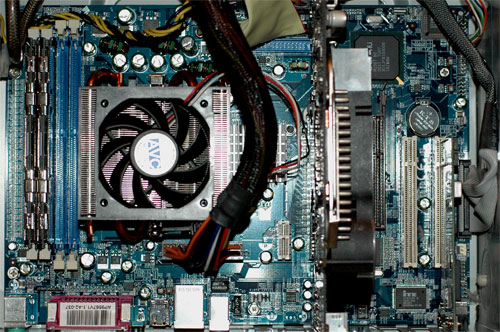
Original Link: https://www.anandtech.com/show/1733
FIRST LOOK: ULi M1695 PCIe/AGP Socket 939 for Athlon 64
by Wesley Fink on July 13, 2005 12:05 AM EST- Posted in
- Motherboards
As we reported form Computex, the talk of the show was ATI's new Crossfire dual-video solution for AMD and Intel. Part of that talk was the development work done with ULi on the ATI South Bridge and the cross-compatibility of the ULi South Bridge using the ATI chipset. ULi is what remains of the ALi chipset division of Acer, and this now independent chipmaker has been very busy in several arenas. In addition to South Bridges which can work with the chipsets of other manufacturers, ULi also makes single-chip and dual-chip solutions for Athlon 64.
ATI certainly had the spotlight with their new chipset, but one of the newest and most interesting chipsets introduced at Computex was also from ULi - the M1695 HyperTransport PCI Express Tunnel Chip for AMD Athlon 64 platforms.
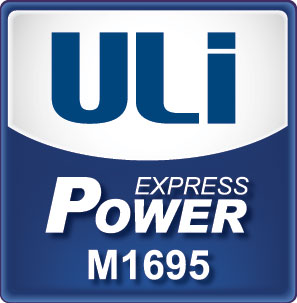

"M1695's innovative HyperTransport tunnel architecture integrates non-blocking symmetrical HyperTransportTM 2.0 links which enables motherboard manufacturers and system integrators to pair up M1695 with other high performance HyperTransport-based chipsets and bridge devices either natively or via the HTXTM connector. When coupled with ULi's M1567 south bridge, the combination offers motherboard manufacturers the unprecedented capability to support PCI Express x16, AGP 8X, PCI graphics cards simultaneously on the same mainboard. Such capability makes it possible to create a fully surrounding virtual reality environment using multiple high resolution displays driven by the three graphics technologies residing in the same computer system."
ULi M1695 Chipset
The ULi M1695 chipset supports Socket 754, 939, and 940. 1000 HT (5X) and higher are fully supported.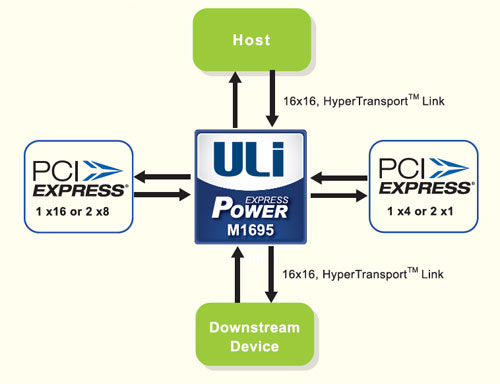
The M1695 provides a PCI Express Interface that can drive either 1 x16 slot of 2 x8 slots. The 2 x8 configuration is called SLI on NVIDIA motherboards, and the option of x16 or 2 x8 is even available in this Reference Board BIOS.
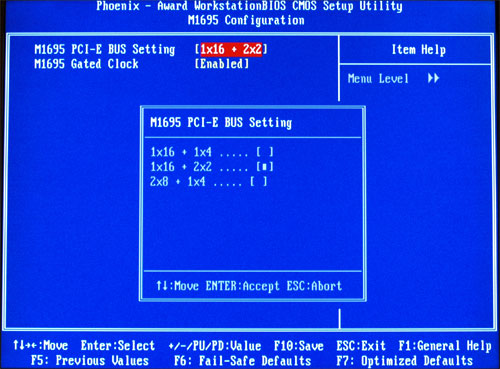
ULi has even been showing an x16 riser card that can be used to support 2 bridged x8 PCIe video cards from a single x16 PCIe slot. Apparently, this is just one of several options to provide "SLI-like" performance with two PCIe cards.
From this basic PCI Express Tunnel chip, ULi talks about flexibility.
Combined with a M1567 South Bridge, as is this Reference Board, you can achieve AGP 8X and PCIe x16/2 x8 combined with support for PCI graphics.
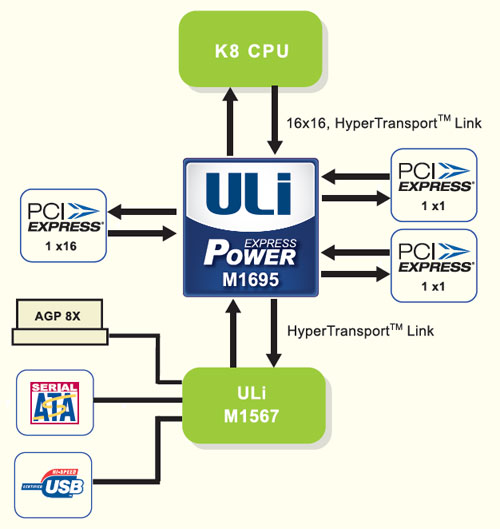
Combining M1695 with an unnamed ULi South Bridge can provide dual x16 slots and additional x1/x2/x4 slots.
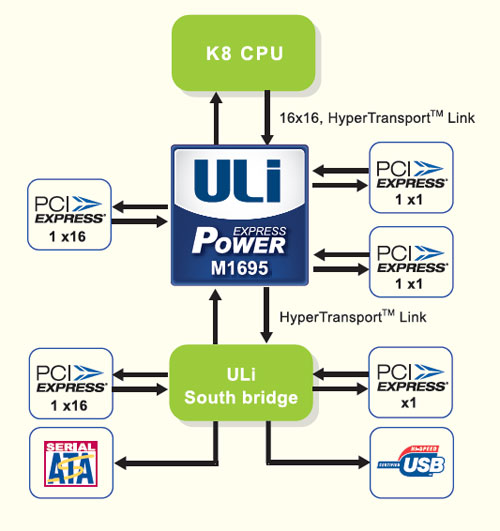
Obviously, ULi designed M1695 and the accompanying South Bridges for the utmost in flexibility. With support for 754/939/940 and all the various combinations that can be used to provide custom graphics capabilities, you will likely see many different ULi configurations in the marketplace.
The flexibility even extends beyond the ULi brand, as the South Bridges can be combined with other North Bridges such as the ATI Crossfire. Similarly, the M1695 can be combined with other chips such as the AMD-8132 PCI-X Tunnel for customized Workstation/Server Applications.

More capabilities can be added with more ULi South Bridges on top of the M1695/AMD-8132.
ULi talks about the flexibility of their M1695 chipset, and we certainly agree. It is refreshing to see so many available choices that give manufacturers the options of building everything from the most basic Socket 754 boards to full-featured 939/940 workstation/server boards with dual x16 PCIe slots and more.
Basic Features: ULi AP9507A (M1695/M1567)
| ULi AP9507A (M1695/M1567) | |
| CPU Interface | Socket 939 Athlon 64 |
| Chipset | ULi M1695 Northbridge - ULi M1567 Southbridge |
| BUS Speeds | 200MHz to 400MHz in 1MHz Increments |
| PCIe Speeds | 75-125MHz in 1MHz Increments |
| PCI/AGP | Fixed at 33/66 |
| Core Voltage | Startup, 0.825V to 1.55V in 0.025V increments |
| CPU Clock Multiplier | Startup, 4x-25x in 1X increments |
| HyperTransport Frequency | 1000MHz (1GHz) |
| HyperTransport Multiplier | 200, 400, 600, 800, 1000 |
| DRAM Voltage | NO Adjustments |
| HyperTransport Voltage | NO Adjustments |
| Memory Slots | Four 184-pin DDR DIMM Slots Dual-Channel Configuration Regular Unbuffered Memory to 4GB Total |
| Expansion Slots | 1 PCIe x16 (or 2 PCIe x8) 1 AGP 8X 2 PCIe x1 2 PCI Slots |
| Onboard SATA/RAID | 2 SATA Drives by ULi M1567 (RAID 0, 1, JBOD) |
| Onboard IDE/IDE RAID | Two Standard ATA133/100/66 (4 drives) |
| Onboard USB 2.0/IEEE-1394 | 8 USB 2.0 ports supported by ULi M1567 No Firewire (Optional) |
| Onboard LAN | 10/100 Ethernet by Realtek PNY (Gigabit LAN Optional) |
| Onboard Audio | AC '97 2.3 6-Channel by Realtek ALC655 |
| BIOS Revision | Award OC50624A (6/24/2005) |
The ULi Award BIOS provides a wide range of BIOS control options, particularly considering that this is a Reference Board used to qualify a chipset. The wide 200 to 400 range for CPU clock was a pleasant surprise, but it is somewhat academic with no memory voltage controls present in the BIOS.
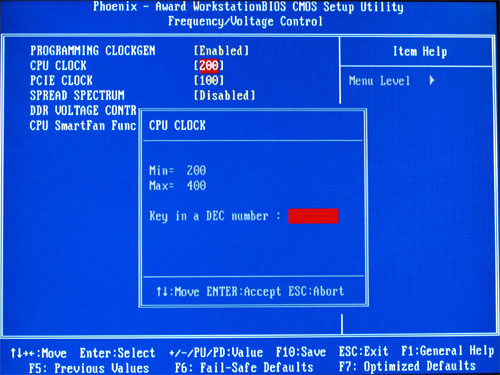
The included vCore adjustments and PCIe speed adjustments were also a nice addition, although the range to just 1.55V is very limited for Clawhammer processors, which are 1.50V at default.
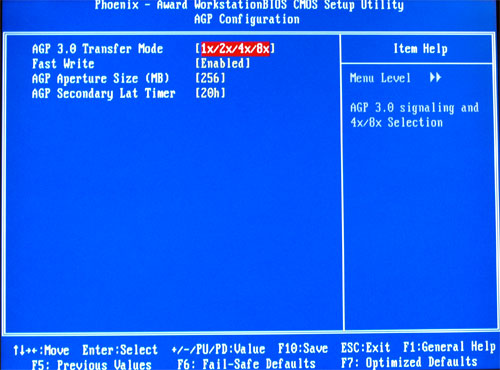
Since the ULi implementation of AGP is real AGP and not derived, the AGP adjustments will look familiar to AGP owners.
Reference Boards are designed for qualification and not for production. It would therefore be a mistake to dwell on the Reference Board layout, except to say that Reference Boards often influence layout of production boards. IDE, SATA, video slots and bottom edge headers all work fine where they are located. However, we hope that production boards will take a different approach to the location of the 24-pin ATX power connector. Located in about the center of the board between the CPU and rear IO ports, there is really no good way to route the heavy cable. In the center of the board, you have to be careful not to interfere with air flow or operation of the CPU and memory.
The location of the floppy connector at the bottom of the board will be a long reach for floppy users. Many buyers don't care about floppies any more, but if you still use them, the bottom of the board is an inconvenient and hard-to-reach location.
Overclocking: ULi M1695/M1567
| Front Side Bus Overclocking Testbed | |
| Default Voltage | |
| Processor: | Athlon 64 4000+ (2.4GHz, 1MB Cache) |
| CPU Voltage: | 1.50V (default 1.50V) |
| Cooling: | Thermaltake Silent Boost K8 Heatsink/Fan |
| Power Supply: | OCZ Power Stream 520W |
| Memory: | OCZ PC3200 EL Platinum Rev. 2 (Samsung TCCD Memory Chips) |
| Hard Drive: | Seagate 120GB 7200RPM SATA 8MB Cache |
| Maximum OC: (Standard Ratio) |
235x12 (4x HT, 2.5-3-3-10) 2820MHz (+17.5%) |
| Maximum FSB: (Lower Ratio) |
300 x 9 (2700MHz) (3x HT) 2 DIMMs in DC mode (+50% Bus Overclock) |
Since there were no voltages for memory, we had to toss our normal overclock procedures out the window to bring you a better idea of the overclocking capabilities of this board. We have seen reports that this new ULi Reference Board, or more specifically the sister Reference Board with the dual 8X riser slot, can reach a CPU Speed setting of 400. Without memory voltage, the only way that this can be tested is by lowering memory ratios to those that can run at default voltage. In other words, we were only measuring the overclock capabilities - an important consideration, since this is a new chipset.
While we could not reach a CPU base speed of 400, we were able to run 300, which is very comparable to results with the NVIDIA nForce4. We also reached an overclock of 235 with our default 12X multiplier. Both these results are competitive with NVIDIA, and they are both outstanding, considering that they were achieved with no memory voltage control. Perhaps the latest version of the M1695 Reference can indeed reach a speed setting of 400. We have asked ULi for a Reference Board with dual x8 riser and we will bring you the test as soon as the board becomes available.
tRAS and Memory Stress Testing
Memory tRAS Recommendations
In past reviews, memory bandwidth tests established that a tRAS setting of 11 or 12 was generally best for nForce2, a tRAS of 10 was optimal for the nForce3 chipset, and a tRAS of 7 was the best choice for the nForce4 chipset. Since this is our first review of a ULi chipset, tRAS timings were first tested with memtest86, a free diagnostic program with its own boot OS that will boot from either a floppy disk or optical disk. Bandwidth of OCZ PC3200 Platinum Rev. 2, based on Samsung TCCD chips, was measured from tRas 5 to tRAS 13 to determine the best tRAS setting for the ULi chipset.| Memtest86 Bandwidth ULi M1695 with Athlon 64 4000+ |
|
| 5 tRAS | 1874 |
| 6 tRAS | 1913 |
| 7 tRAS | 1953 |
| 8 tRAS | 1953 |
| 9 tRAS | 1994 |
| 10 tRAS | 1994 |
| 11 tRAS | 1994 |
| 12 tRAS | 1874 |
| 13 tRAS | 1974 |
The best bandwidth was achieved with this combination of ULi M1695/4000+/TCCD in the 9 to 11 range, so a mid-value tRAS of 10 was chosen for all tests. It appears that optimal tRAS timings may also be memory dependent, so we recommend a quick series of memtest86 to establish the optimum tRAS timings for other memories on the ULi chipset.
Memory Stress Test
Our memory stress test measures the ability of the ULi to operate at its officially supported memory frequency (400MHz DDR), at the lowest memory timings that OCZ PC3200 Platinum Rev. 2 modules will support. All DIMMs used for stress testing were 512MB double-sided (or double-bank) memory. To make sure that memory performed properly in Dual-Channel mode, memory was only tested using either one dual-channel (2 DIMMs) or 2 dual-channels (4 DIMMs).| Stable DDR400 Timings - One Dual-Channel (2/4 DIMMs populated) |
|
| Clock Speed: | 200MHz |
| CAS Latency: | 2.0 |
| RAS to CAS Delay: | 2T |
| RAS Precharge: | 10T |
| Precharge Delay: | 2T |
| Command Rate: | 1T |
Using two DIMMs in Dual-Channel 128-bit mode, the memory performed in all benchmarks at the fastest 2-2-2-10 timings at default voltage, which was the only memory voltage available.
| Stable DDR400 Timings - 4 DIMMs (4/4 DIMMs populated) |
|
| Clock Speed: | 200MHz |
| CAS Latency: | 2.0 |
| RAS to CAS Delay: | 2T |
| RAS Precharge: | 10T |
| Precharge Delay: | 2T |
| Command Rate: | 2T |
Tests with all four DIMM slots populated on the ULi M1695 required a 2T Command Rate with 4 DIMMs in two dual channels. This is the pattern seen on other top-performing Socket 939 boards. However, the ULi had no problem running at a 200 CPU speed setting with 4 double-sided DIMMs. This performance is certainly competitive with the best that we have seen on nForce4 motherboards for Socket 939.
Test Setup
| Performance Test Configuration | |
| Processor(s): | AMD Athlon 64 4000+ (2.4GHz) Socket 939 |
| RAM: | 2 x 512MB OCZ PC3200 Platinum Rev. 2 |
| Hard Drive(s): | Seagate 120GB 7200 RPM SATA (8MB Buffer) |
| Video AGP & IDE Bus Master Drivers: | NVIDIA nForce 6.56 |
| Video Cards: | NVIDIA 6800 Ultra (PCIe) NVIDIA 6800 Ultra (AGP) |
| Video Drivers: | NVIDIA nForce 77.72 |
| Operating System(s): | Windows XP Professional SP2 Direct X 9.0c |
| Motherboards: | ULi AP9567A (M1695/M1567) Abit AN8 Fatal1ty Biostar NF4UL-A9 Chaintech VNF4-Ultra DFI LANParty UT nF4 Ultra-D ECS KN1 Extreme Epox 9NPA+ Ultra Winfast NF4UK8AA (Foxconn) |
Tests used OCZ PC3200 Platinum Rev. 2, which uses Samsung TCCD chips. All memory ran at 2-2-2-10 timing in all benchmarks.
The NVIDIA 6800 Ultra was used for testing both PCIe and AGP performance on the ULi and Biostar boards. The 6800 Ultra video cards were tested at the same video timings and differed only in interface - AGP or PCIe. Resolution in all benchmarks is 1280x1024x32 unless noted otherwise.
Results for the ULi M1695/M1567 are color-coded red for PCIe and Orange for AGP in all graphs. Results for the other seven boards, all based on the nForce4 Ultra chipset, are in blue.
General Performance & Encoding
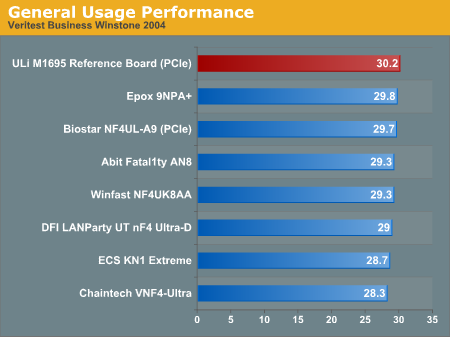
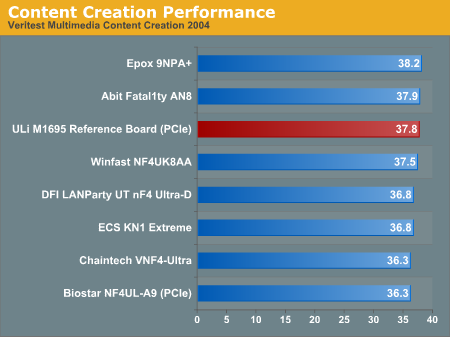
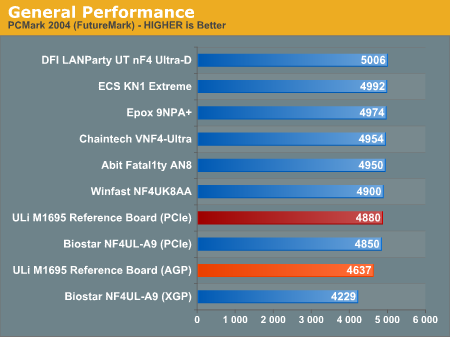
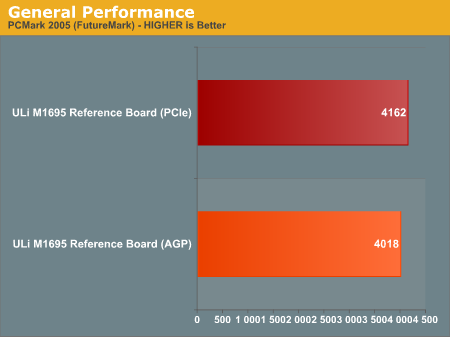
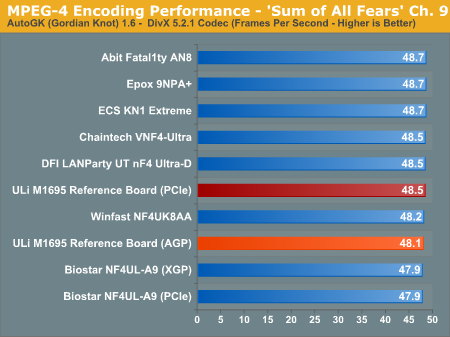
Gaming Performance
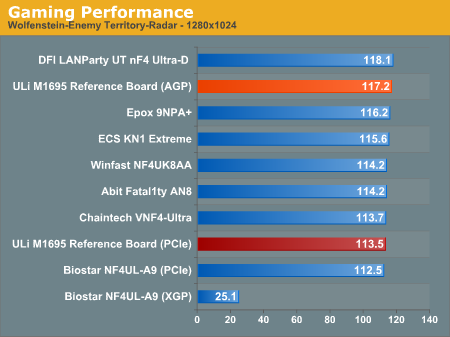
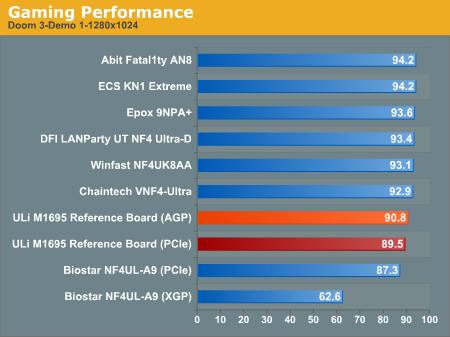

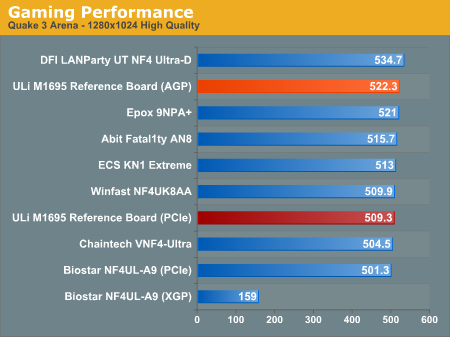
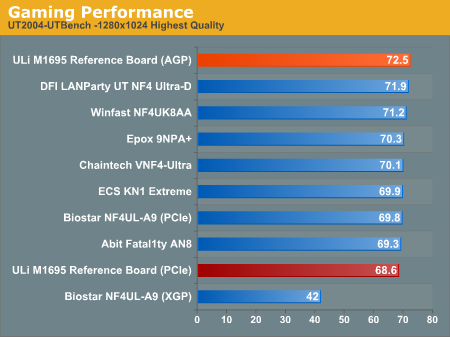
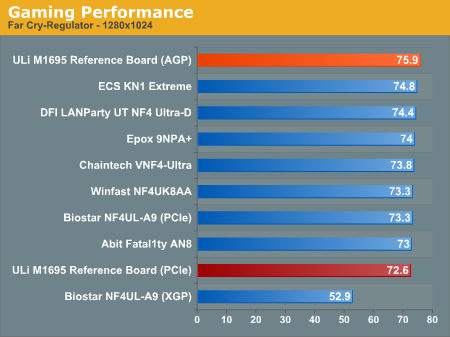
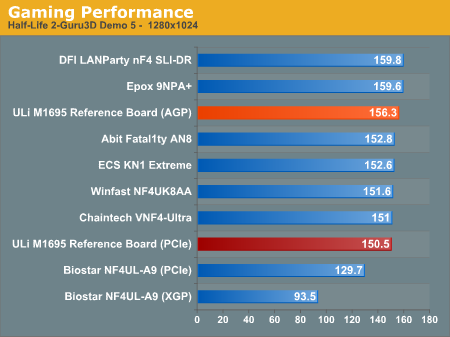
We think that the explanation may be a bit different in looking at these performance charts. ULi is experienced in AGP designs and tweaking, but this is really their first venture into PCIe space. It appears that the PCIe performance is quite good, but it requires a bit more tweaking to bring performance to the excellent performance levels of ULi AGP. When that refinement is complete, the ULi will likely be one of the fastest performers among AMD Athlon 64 boards.
Our Take
There are several questions that really need answering in our first look at the new ULi M1695/M1567 chipset. First and foremost, how does it compare to the excellent performance of the NVIDIA nForce4 chipset? Our brief testing here confirms that the ULi competes very well against NVIDIA, and is a performance drop-in to the NVIDIA performance levels. This is very good news for those shopping for Athlon 64 Socket 939 boards. ULi is a solid choice and competition means better buys for you. It will likely still be a month to 6 weeks before you will see retail M1695/M1567 boards for sale, but make no mistake that the ULi is a very good choice, featuring excellent performance.Second, there is the unique question of ULi AGP on this PCIe board. How does it perform? We are glad to say that ULi AGP is the first AGP on any PCIe board that doesn't require compromises. Those of you who want to take your high-end AGP card to a new PCIe board will be ecstatic over the performance of your AGP video card on the ULi board. It will work extremely well, as will a future PCIe card or a PCI card or any other combination of these three. This is absolutely unique, and it makes the compromise solutions, which derive AGP from PCI with degraded performance, totally obsolete. You do not need to compromise AGP performance just to get a PCIe board with this ULi M1695/M1567 chipset.
Next, there is the question of where ULi may be positioned in the marketplace. This is a tough call because we have seen excellent chipsets, like those from SiS, that have been relegated to the bargain bin because no manufacturer will support them. ULi has a bit more promise that we might otherwise see with their new chipsets. First, there is the fact that ATI selected ULi as a development partner for their South Bridge chips on the new Crossfire platform. That alone carries tremendous weight in getting manufacturers to take the new ULi chipsets seriously.
There is also the fact that ULi has some very unique and flexible solutions among their new offerings. The ability to do x16 or 2 x8 with a BIOS switch and riser card will appeal to many. In fact, x16/2 x8, AGP and PCI could all be theoretically combined on the same board. With a soon-to-be-available South Bridge, ULi is also saying that they will support Dual x16 lanes for a Workstation/Server type solution at a mainstream price. That will certainly appeal to many looking at the video high end. There is also the ability to interface with AMD's PCI-X workstation chips in an even more amazing array of options. This flexibility should make ULi attractive to many manufacturers and to a wide range of buyers.
The new ULi M1695/M1567 chipset is both unique in its full-blown AGP support on a PCIe board and fully competitive in performance with the best Athlon 64 solutions currently available. PCIe performance could use a bit more tuning, but it is already competitive. If ULi can bring PCIe performance to the levels that they currently enjoy with AGP on this same board, this could well be the fastest Athlon 64 chipset that you can buy. We could wish for SATA 2 support and integrated Gigabit LAN, but even those are coming with the M1575 South Bridge slated for September/October production.
ULi did a great job with their new PCIe/AGP chipset. If you are in the market for a new Socket 939 board, then boards based on the ULi M1695/M1567 should definitely be on your shopping list. If you by chance plan to use AGP on your new PCIe board, then ULi M1695/M1567 is the only board that you should have on your shopping list. This AGP on PCIe really works, there are no compromises, and you will not be disappointed.

